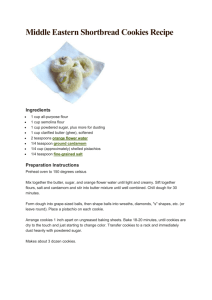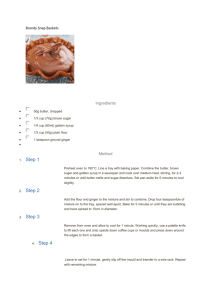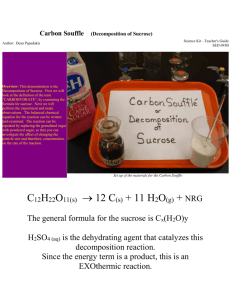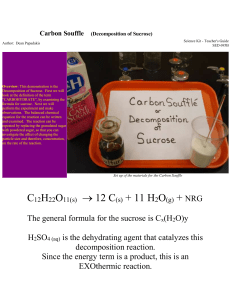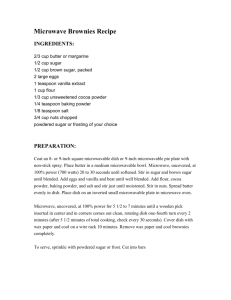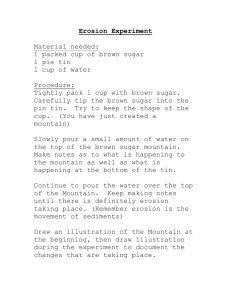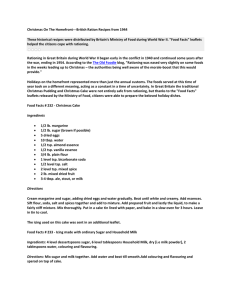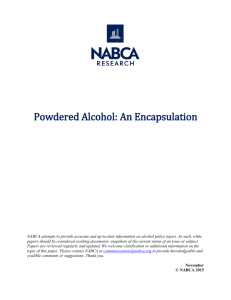1st Quarter Extra Credit
advertisement
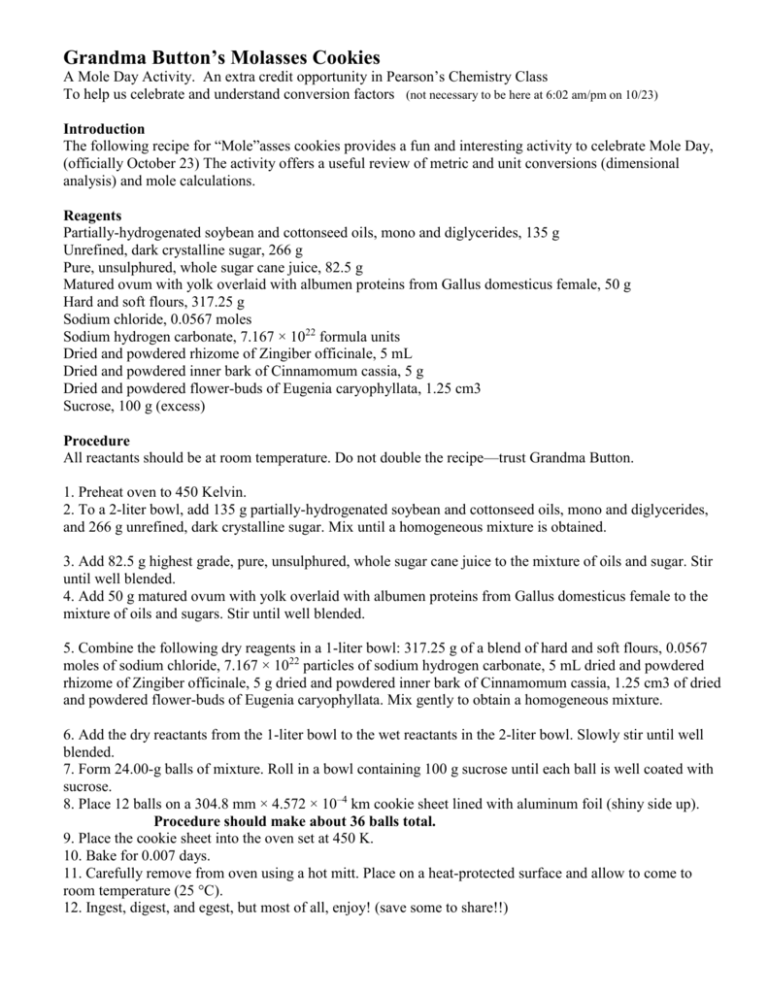
Grandma Button’s Molasses Cookies A Mole Day Activity. An extra credit opportunity in Pearson’s Chemistry Class To help us celebrate and understand conversion factors (not necessary to be here at 6:02 am/pm on 10/23) Introduction The following recipe for “Mole”asses cookies provides a fun and interesting activity to celebrate Mole Day, (officially October 23) The activity offers a useful review of metric and unit conversions (dimensional analysis) and mole calculations. Reagents Partially-hydrogenated soybean and cottonseed oils, mono and diglycerides, 135 g Unrefined, dark crystalline sugar, 266 g Pure, unsulphured, whole sugar cane juice, 82.5 g Matured ovum with yolk overlaid with albumen proteins from Gallus domesticus female, 50 g Hard and soft flours, 317.25 g Sodium chloride, 0.0567 moles Sodium hydrogen carbonate, 7.167 × 1022 formula units Dried and powdered rhizome of Zingiber officinale, 5 mL Dried and powdered inner bark of Cinnamomum cassia, 5 g Dried and powdered flower-buds of Eugenia caryophyllata, 1.25 cm3 Sucrose, 100 g (excess) Procedure All reactants should be at room temperature. Do not double the recipe—trust Grandma Button. 1. Preheat oven to 450 Kelvin. 2. To a 2-liter bowl, add 135 g partially-hydrogenated soybean and cottonseed oils, mono and diglycerides, and 266 g unrefined, dark crystalline sugar. Mix until a homogeneous mixture is obtained. 3. Add 82.5 g highest grade, pure, unsulphured, whole sugar cane juice to the mixture of oils and sugar. Stir until well blended. 4. Add 50 g matured ovum with yolk overlaid with albumen proteins from Gallus domesticus female to the mixture of oils and sugars. Stir until well blended. 5. Combine the following dry reagents in a 1-liter bowl: 317.25 g of a blend of hard and soft flours, 0.0567 moles of sodium chloride, 7.167 × 1022 particles of sodium hydrogen carbonate, 5 mL dried and powdered rhizome of Zingiber officinale, 5 g dried and powdered inner bark of Cinnamomum cassia, 1.25 cm3 of dried and powdered flower-buds of Eugenia caryophyllata. Mix gently to obtain a homogeneous mixture. 6. Add the dry reactants from the 1-liter bowl to the wet reactants in the 2-liter bowl. Slowly stir until well blended. 7. Form 24.00-g balls of mixture. Roll in a bowl containing 100 g sucrose until each ball is well coated with sucrose. 8. Place 12 balls on a 304.8 mm × 4.572 × 10–4 km cookie sheet lined with aluminum foil (shiny side up). Procedure should make about 36 balls total. 9. Place the cookie sheet into the oven set at 450 K. 10. Bake for 0.007 days. 11. Carefully remove from oven using a hot mitt. Place on a heat-protected surface and allow to come to room temperature (25 °C). 12. Ingest, digest, and egest, but most of all, enjoy! (save some to share!!) For Extra Credit: You may bake in groups of up to 4. Your group must submit a sample of your product (3 or 4 cookies; ); you must EACH submit a sheet of DETAILED CONVERSIONS with your name on it to receive the extra credit. Useful Conversion Factors Partially hydrogenated soybean and cottonseed oils, mono and diglycerides = Crisco® shortening 1 cup of Crisco = 180 g Unrefined dark crystalline sugar = Dark brown sugar 1 tablespoon = 16.625 g of dark brown sugar 16 tablespoons = 1 cup Pure, unsulphured, whole sugar cane juice = Molasses 1 teaspoon = 6.875 g molasses 3 teaspoons = 1 tablespoon Matured ovum with yolk overlaid with albumen proteins from Gallus domesticus female = Chicken egg 1 large chicken egg with shell removed = 50 g Hard and soft flours = All-purpose flour 1 cup of all-purpose flour = 141 g Sodium chloride = Table salt 1 teaspoon table salt = 6.63 g Sodium hydrogen carbonate = sodium bicarbonate(NaHCO3) = Baking soda; remember you will need to calculate the molar mass 1 mole = 6.02 × 1023 particles 1 teaspoon baking soda = 5 g Dried and powdered rhizome of Zingiber officinale = Ginger 1 metric teaspoon = 5 mL Dried and powdered inner bark of Cinnamomum cassia = Cinnamon 1 metric teaspoon cinnamon = 2.5 g Dried and powdered flower-buds of Eugenia caryophyllata = Ground clove 1 cm3 = 1 mL Sucrose = Table sugar 1 cup = 200 g sucrose °C + 273 = Kelvin 5/9 (°F – 32) = °C 1 inch = 2.54 cm 1000 m = 1 km 10 mm = 1 cm Hints and examples Remember to think about the number of significant figures that are allowed in the final answers. 1 cup 135 g of Crisco × ——— = 0.750 cups = 3/4 cup Crisco 180 g 1 tablespoon 1 cup 266 g dark brown sugar × —————— × ——————— = 1 cup brown sugar 16.625 g 16 tablespoons
